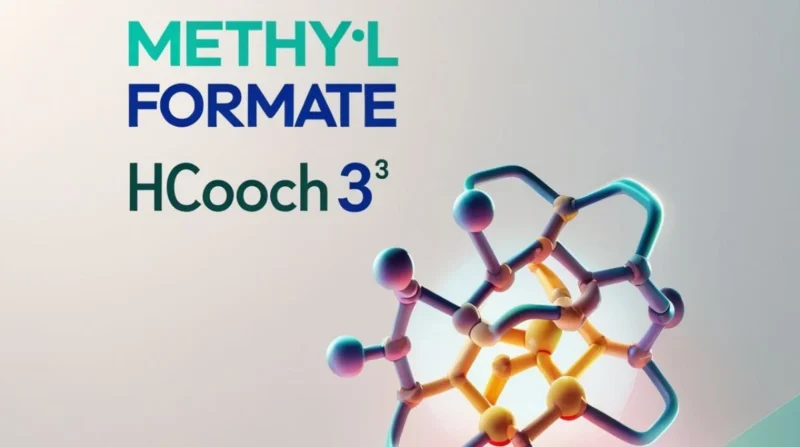Table of Contents
- Physical and Chemical Properties
- Production Methods
- General Industrial Applications
- Synthesis of HCOOCH CH2 H2O
- Applications in Organic Synthesis
- 1. As a Building Block in Chemical Reactions
- 2. Intermediate in the Synthesis of Glycol Ethers
- 3. Use in Esterification Reactions
- 4. Reducing Agent in Specific Reactions
- 5. Precursor to Polymers and Resins
- 6. Used in Protecting Group Strategies
- 7. Precursor in Pharmaceutical Synthesis
- 8. Functionalization of Alcohols and Carboxylic Acids
- 9. Green Chemistry Potential
- Applications of Ethylene Glycol Monoformate
- Comparison with Similar Compounds
- Safety Considerations
- Environmental Impact
- Market Trends and Future Prospects
- Conclusion
Methyl formate, chemically represented as HCOOCH₃, is a colorless, volatile liquid with a pleasant, ether-like odor. Its unique chemical properties and versatility make it a valuable compound in various industrial applications. This article provides a comprehensive overview of methyl formate, covering its properties, production methods, applications, safety considerations, environmental impact, market trends, and future prospects.
Physical and Chemical Properties
Methyl formate has a molecular weight of 60.05 g/mol and exhibits a boiling point of approximately 32°C (89.6°F), classifying it as a highly volatile substance. Its density is around 0.97 g/cm³ at 20°C. The compound is moderately soluble in water, with a solubility of about 30% at room temperature. Chemically, methyl formate is the methyl ester of formic acid, and it readily participates in hydrolysis reactions, yielding methanol and formic acid. This reactivity is particularly significant in various chemical synthesis processes.
Production Methods
Industrial Synthesis
The predominant industrial method for producing methyl formate involves the carbonylation of methanol. In this process, methanol reacts with carbon monoxide in the presence of a strong base catalyst, such as sodium methoxide, to produce methyl formate:
CH₃OH + CO → HCOOCH₃
This method is favored for its efficiency and high yield.
Laboratory Preparation
In laboratory settings, methyl formate can be synthesized through the esterification of formic acid with methanol:
HCOOH + CH₃OH → HCOOCH₃ + H₂O
While straightforward, this method is less commonly employed on an industrial scale due to the availability and cost-effectiveness of the carbonylation process.
General Industrial Applications
Chemical Intermediate
Methyl formate serves as a crucial intermediate in the production of various chemicals, including formamide, dimethylformamide (DMF), and formic acid. These compounds are foundational in the manufacture of pharmaceuticals, agrochemicals, and other industrial products.
Solvent
Due to its high volatility and solvent properties, methyl formate is utilized as a solvent in various applications, including paint and coating formulations, adhesives, and cleaning agents. Its exceptional solvency power, coupled with its low toxicity and volatility, makes it a preferred choice in these applications.
Blowing Agent
In the production of polyurethane and other polymeric foams, methyl formate acts as a blowing agent. Its properties facilitate the formation of lightweight, insulating foam structures used in construction, packaging, and automotive industries.
Fumigant and Larvicide
Methyl formate is employed as a fumigant and larvicide, particularly for tobacco, dried fruits, and cereals. Its efficacy in pest control contributes to the preservation of agricultural products.
Refrigerant
Historically, methyl formate was used as a refrigerant due to its favorable thermodynamic properties. However, its use in this capacity has declined with the advent of less toxic and more efficient alternatives.
Synthesis of HCOOCH CH2 H2O
Ethylene glycol monoformate, also known as 2-hydroxyethyl formate, is an organic compound with the chemical formula HCOOCH₂CH₂OH. This molecule features both ester (-COO-) and hydroxyl (-OH) functional groups, making it significant in various chemical synthesis applications. The synthesis of ethylene glycol monoformate can be achieved through several methods, each with its advantages and considerations.
1. Direct Esterification of Glycolic Acid with Methanol
One common approach involves the esterification of glycolic acid with methanol. In this process, glycolic acid reacts with methanol in the presence of an acid catalyst to produce methyl glycolate (HCOOCH₂CH₃) and water. This method is straightforward and widely utilized in industrial settings.
2. Hydrogenation of Dimethyl Oxalate
Another method entails the catalytic hydrogenation of dimethyl oxalate (DMO). In this reaction, DMO undergoes hydrogenation in the presence of a catalyst, such as phosphorus-modified cobalt on silica (Co₈P/SiO₂), resulting in the formation of methyl glycolate. This technique has been reported to achieve high conversion rates and selectivity towards methyl glycolate.
3. Carbonylation of Formaldehyde
The carbonylation of formaldehyde represents another viable synthesis route. In this process, formaldehyde reacts with carbon monoxide under acidic conditions to form glycolic acid, which can subsequently be esterified with methanol to yield methyl glycolate. This method requires careful control of reaction conditions due to the reactivity of formaldehyde and carbon monoxide.
4. Reaction of Glyoxal with Methanol
Additionally, methyl glycolate can be synthesized by reacting glyoxal with methanol over solid basic catalysts composed of mixed oxides of magnesium, zirconium, and aluminum. This method has been shown to provide high selectivity towards methyl glycolate, making it an efficient alternative.
Each of these synthesis methods offers distinct advantages and may be selected based on factors such as desired yield, purity, available starting materials, and specific application requirements.
Applications in Organic Synthesis
Ethylene glycol monoformate (HCOOCH₂CH₂OH), sometimes referred to as 2-hydroxyethyl formate, plays a useful role in organic synthesis because of its dual-functionality. It carries both an ester group (from formic acid) and a primary alcohol group (from ethylene glycol), which makes it a versatile intermediate in the preparation of various organic compounds. Here are several important applications of this compound in organic synthesis, written in simple terms to help explain how it fits into everyday chemical and industrial processes.
1. As a Building Block in Chemical Reactions
Because HCOOCH₂CH₂OH contains two reactive groups, it can be used as a building block in more complex molecules. The hydroxyl group (-OH) can react in one direction, and the formate (ester) group can react in another. This dual reactivity makes it ideal for constructing larger organic molecules like pharmaceuticals, agrochemicals, and polymers.
For example, chemists might use it to create molecules with both hydrophilic (water-loving) and hydrophobic (water-repelling) parts, which is useful in designing surfactants, emulsifiers, and bioactive molecules.
2. Intermediate in the Synthesis of Glycol Ethers
HCOOCH₂CH₂OH can be used as a precursor to glycol ethers, which are important industrial solvents. Glycol ethers are widely used in cleaning products, paints, and inks. The formate group can be modified or removed, while the -OH group can be used to introduce ether linkages, forming molecules that have excellent solvency and low volatility.
3. Use in Esterification Reactions
This compound can act as a starting point for further esterification, where the -OH group reacts with other acids to form more esters. These esters can be tailored for specific purposes, such as plasticizers (to make plastics flexible), or synthetic lubricants. The ability to selectively modify either end of the molecule gives chemists a lot of flexibility in molecular design.
4. Reducing Agent in Specific Reactions
The formate group in HCOOCH₂CH₂OH can serve as a source of formyl or as a mild reducing agent in chemical reactions. In some synthetic pathways, formate esters are used to introduce carbon atoms into molecules or to reduce certain functional groups under mild conditions, which helps preserve the rest of the molecule’s structure.
5. Precursor to Polymers and Resins
Because of its bifunctional nature, this compound can also be used in polymer synthesis, particularly in forming polyesters or polyurethanes. It may be used to create crosslinking agents or reactive monomers, which are the small units that join together to form large plastic-like materials. This application is especially useful in coatings, adhesives, and sealants.
6. Used in Protecting Group Strategies
In more advanced organic chemistry, especially during multi-step synthesis of complex compounds like drugs, it’s common to protect parts of a molecule to stop them from reacting. Compounds like ethylene glycol monoformate can be used to temporarily block (or protect) a functional group such as an alcohol or acid so that chemists can work on other parts of the molecule without interference. Once the desired transformation is complete, the protecting group can be removed.
7. Precursor in Pharmaceutical Synthesis
Some medicinal compounds require molecules that are both water-soluble and chemically active. HCOOCH₂CH₂OH fits that profile well. It can be used to synthesize intermediate compounds in the creation of active pharmaceutical ingredients (APIs). Its hydroxyl group improves water compatibility, while the ester group can participate in key transformations needed to build biologically active compounds.
8. Functionalization of Alcohols and Carboxylic Acids
Chemists often need to functionalize or modify alcohols and carboxylic acids to fine-tune their chemical behavior. HCOOCH₂CH₂OH is often involved in such transformations. It can be used in transesterification reactions, where one ester is converted into another, or it can be coupled with acid derivatives to create more reactive or bioavailable compounds.
9. Green Chemistry Potential
Because this compound can be derived from relatively simple and less hazardous feedstocks, it fits well into the framework of green chemistry. Its ability to take part in clean, high-yield reactions with minimal waste is a valuable trait. Scientists looking to design sustainable and environmentally friendly synthetic processes often consider compounds like HCOOCH₂CH₂OH.
Applications of Ethylene Glycol Monoformate
Catalytic Applications
Ethylene glycol monoformate is utilized as a solvent and catalyst carrier in organic synthesis. Its ability to dissolve a wide range of substances makes it suitable for facilitating various chemical reactions. Additionally, it can participate directly in reactions, contributing to the formation of more complex molecules. For instance, lipase-catalyzed esterification processes have employed ethylene glycol derivatives to produce specific esters, demonstrating its role in enzymatic catalysis.
Industrial Applications
In the industrial sector, ethylene glycol monoformate serves multiple purposes:
- Solvent: It is employed as a solvent in the production of coatings, paints, and inks, enhancing their solubility and stability.
- Chemical Intermediate: The compound acts as a precursor in the synthesis of various chemicals, including solvents and resins, contributing to the manufacturing of products like adhesives and plastics.
- Heat Transfer Fluids: Ethylene glycol derivatives are commonly used in heat transfer applications, such as in HVAC systems and plastic mold making, due to their excellent thermal properties.
Environmental Applications
Ethylene glycol monoformate’s environmental applications are primarily associated with its parent compound, ethylene glycol:
- De-icing Solutions: Ethylene glycol is a key component in de-icing formulations for aircraft and runways, preventing ice formation in cold environments.
- Antifreeze: It is widely used in antifreeze products for automotive and industrial applications, helping to regulate engine temperatures and prevent freezing.
While these applications are beneficial, it is essential to manage and dispose of ethylene glycol-containing products properly to minimize environmental impact, as improper disposal can lead to contamination of water sources.
Pharmaceutical Applications
In the pharmaceutical industry, ethylene glycol monoformate and its derivatives have notable applications:
- Solubilizer and Excipient: Ethylene glycol derivatives are used as solubilizers in drug formulations, enhancing the solubility of active pharmaceutical ingredients and improving drug delivery.
- Hygroscopic Agent: They function as hygroscopic agents, maintaining moisture content in pharmaceutical products to ensure their stability and efficacy.
These applications highlight the compound’s role in improving the formulation and performance of various pharmaceutical products.
Comparison with Similar Compounds
Ethylene glycol monoformate (2-hydroxyethyl formate) is a compound that combines both ester and hydroxyl functional groups, making it unique among related substances. To understand its distinct characteristics, it’s helpful to compare it with structurally similar compounds such as ethylene glycol, diethylene glycol, and polyethylene glycol.
1. Ethylene Glycol (EG):
- Structure: Consists of two hydroxyl (-OH) groups attached to a two-carbon chain (C₂H₆O₂).
- Properties: Colorless, odorless, syrupy liquid with a molecular weight of 62.07 g/mol; miscible with water due to its hydrophilic nature.
- Uses: Primarily used as an antifreeze agent in cooling systems and as a precursor in polyester fiber production.
2. Diethylene Glycol (DEG):
- Structure: Composed of two ethylene glycol units linked by an ether bond, resulting in the formula C₄H₁₀O₃.
- Properties: Higher boiling point and viscosity than EG; molecular weight of 106.12 g/mol.
- Uses: Employed in the manufacture of plasticizers, resins, and as a solvent in various applications.
3. Polyethylene Glycol (PEG):
- Structure: A polymer consisting of repeating ethylene glycol units, with the general formula H(OCH₂CH₂)ₙOH, where ‘n’ indicates the number of repeating units.
- Properties: Molecular weight varies depending on the number of units; can range from a viscous liquid to a solid.
- Uses: Utilized in pharmaceuticals, cosmetics, and as a lubricant due to its solubility and low toxicity.
Comparison with Ethylene Glycol Monoformate (EGMF):
- Structure: EGMF contains both an ester group (-COO-) and a hydroxyl group (-OH) attached to a two-carbon chain (C₃H₆O₃).
- Properties: Molecular weight of 90.08 g/mol; combines characteristics of both esters and alcohols, leading to unique reactivity.
- Uses: Acts as an intermediate in organic synthesis, particularly in the formation of other esters and polymers.
In summary, while ethylene glycol, diethylene glycol, and polyethylene glycol primarily function as solvents and antifreeze agents, ethylene glycol monoformate’s dual functional groups confer distinct reactivity, making it valuable in specialized chemical syntheses.
Safety Considerations
Methyl formate is a flammable liquid with a flash point of -19°C (-2°F), necessitating careful handling and storage. Exposure to methyl formate can cause irritation to the eyes, skin, and respiratory system. Inhalation of high concentrations may lead to dizziness, headache, or even more severe health effects. The Occupational Safety and Health Administration (OSHA) has established permissible exposure limits to mitigate these risks.
Appropriate safety measures include using personal protective equipment (PPE), ensuring adequate ventilation in work areas, and adhering to proper storage protocols to prevent accidental exposure or ignition.
Environmental Impact
Methyl formate has a relatively short atmospheric lifetime of approximately 3 days, indicating that it does not persist long in the environment. It is compliant with environmental regulations such as the Kyoto and Montreal protocols, with a global warming potential of less than 1.5 and an ozone depletion potential of zero.
However, methyl formate is classified as a volatile organic compound (VOC), and its emissions can contribute to air quality concerns. Therefore, its use and disposal should be managed to minimize environmental impact.
Market Trends and Future Prospects
The global methyl formate market is projected to experience moderate growth in the coming years. Factors driving this growth include increasing demand in the pharmaceutical industry, where methyl formate is used as a solvent and intermediate, and its application as a fumigant and larvicide in agriculture. Additionally, the compound’s use in metal foundries contributes to market expansion.
Emerging research suggests potential new applications for methyl formate, such as its use as a hydrogen energy carrier. This development could open new avenues for the compound in the context of renewable energy and sustainability.
Conclusion
Methyl formate (HCOOCH₃) is a versatile chemical with a range of applications spanning chemical manufacturing, agriculture, and beyond. Its unique properties facilitate its use as a solvent, intermediate, and insecticide. Understanding its characteristics, production methods, and applications underscores the importance of methyl formate in various industrial processes. As with all chemicals, adherence to safety protocols is paramount to ensure its effective and safe utilization.









